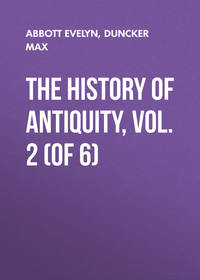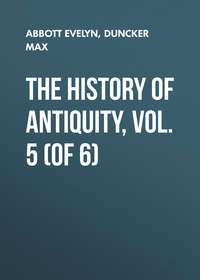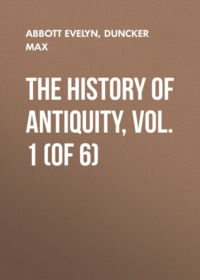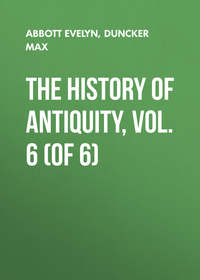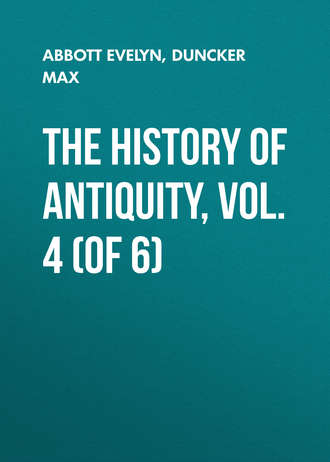 полная версия
полная версияThe History of Antiquity, Vol. 4 (of 6)
429
Burnouf, loc. cit. p. 186. Köppen, loc. cit. s. 220.
430
Burnouf, loc. cit. p. 167.
431
e. g. Burnouf, loc. cit. p. 487.
432
These are the four sublime truths (aryani satyani) of Buddhism; pain, the creation of pain, the annihilation of pain, and the way which leads to the annihilation of pain.
433
Burnouf, loc. cit. p. 410, 430.
434
Burnouf, loc. cit. p. 418, 428, 629.
435
Burnouf, loc. cit. p. 498, 508.
436
Burnouf, loc. cit. p. 459, 462.
437
Burnouf, loc. cit. p. 509, 510.
438
Burnouf, loc. cit. p. 460.
439
Burnouf, loc. cit. p. 418.
440
Burnouf, loc. cit. p. 405.
441
Burnouf, loc. cit. p. 418, 420.
442
Burnouf, loc. cit. p. 251, 327, 460.
443
Burnouf, loc. cit. p. 389, 393, 486.
444
Burnouf, loc. cit. p. 486 ff.
445
Burnouf, loc. cit. p. 460.
446
3 Burnouf, loc. cit. p. 488-509. For further information about the series of the causes of being (nidana), which is not very intelligible, see Köppen, s. 609. My object is merely to indicate the line of argument.
447
Burnouf, "Introduction," p. 73, 83, 589 ff.
448
Burnouf, loc. cit. p. 252.
449
Burnouf, loc. cit. p. 326.
450
Schlagintweit, "Buddhism in Tibet," p. 91 ff.
451
Burnouf, loc. cit. p. 369.
452
Burnouf, loc. cit. p. 265.
453
Burnouf, loc. cit. p. 271.
454
Burnouf, loc. cit. p. 203, 342.
455
Burnouf, loc. cit. p. 462, 510.
456
Köppen, s. 223.
457
Köppen, s. 125.
458
Burnouf, "Introduction," p. 254.
459
Burnouf, "Introduction," p. 327.
460
Burnouf, "Introduction," p. 253, 410.
461
Burnouf, "Introduction," p. 429.
462
Burnouf, "Introduction," p. 274.
463
Burnouf, "Introduction," p. 325.
464
Lassen, "Ind. Alterth." 2, 258.
465
Burnouf, loc. cit. p. 300.
466
Burnouf, loc. cit. p. 299.
467
Burnouf, loc. cit. p. 261.
468
Burnouf, loc. cit. p. 126, 153. Köppen, s. 224.
469
Burnouf, loc. cit. p. 163, 189, 145, 190, 211.
470
Burnouf, loc. cit. p. 101.
471
Köppen, s. 111.
472
Burnouf, loc. cit. p. 126.
473
Burnouf, loc. cit. p. 414.
474
Burnouf, loc. cit. p. 195, 274, 381, 382.
475
Burnouf, loc. cit. p. 174, 183.
476
Burnouf, loc. cit. p. 375, 376.
477
Burnouf, loc. cit. p. 198.
478
Burnouf, loc. cit. p. 162, 197, 205, 212, 277.
479
Burnouf, loc. cit. p. 206.
480
Burnouf, loc. cit. p. 205 ff.
481
Burnouf, loc. cit. p. 351; Lassen, "Ind. Alterth." 22, 80.
482
Burnouf, "Introduction," p. 351, 372. Lassen, "Ind. Alterth." 2, 80 ff. Köppen, "Rel. d. Buddha," s. 117.
483
Lassen, loc. cit. 22, 86 ff.
484
Lassen, loc. cit. 22, 89.
485
Von Gutschmid, "Beiträge," s. 81.
486
Lassen, loc. cit. 22, 91. n. 1.
487
Burnouf, loc. cit. p. 147, 435.
488
Diod. 2, 39. Strabo, p. 702. Arrian, "Ind." 10, 6, 7.
489
Lassen, "Ind. Alterth." 12, 649, 650.
490
Manu, 10, 45.
491
The date follows from the fact that the settlers who are said to have landed in Ceylon in 543 B.C. according to the era of the Singhalese, find the kingdom of the Pandus and the city of Mathura in existence. Lassen, loc. cit. 22, 23 ff; 99 ff; cp. infr. p. 372.
492
Benfey, "Indien," s. 221. Neither the book of the law nor the sutras of the Buddhists mention the Pariahs, often as they speak of the Chandalas.
493
Lassen, "Ind. Alterth." 22, 99 ff., 108 ff.
494
Lassen, loc. cit. 12, 137, n. 4, 22, 99 ff. The island then received from the city of Tamraparni the name which is still in use among the natives; Tamraparni is in Pali, Tambapanni; and from this is formed the Taprobane of the Greeks. Lanka is no doubt the older name, but like Sinhala it is still in use.
495
Westergaard, "Ueber Buddha's Todesjahr," s. 100 ff. Lassen, loc. cit. 22, 100 ff.
496
Ritter, "Geographie," 4, 2, 519-542. Lassen, "Ind. Alterth." 1. 377. These are, no doubt, the Padæans and Calatians of Herodotus (3, 98, ff.). Lassen explains this name by padya, bad, and kala, black.
497
Strabo, p. 72, 690.
498
Arrian, "Ind." 8; Plin. "Hist. Nat." 6, 24.
499
Burnouf, "Introduction," p. 351, 372. Köppen, "Religion des Buddha," s. 117. On the forms of the Sanskrit in which the old sutras were written, Burnouf, loc. cit. p. 106 ff. Lassen, loc. cit. 22, 493.
500
Burnouf, loc. cit. p. 217, 232. Lassen, loc. cit. 2, 79, 80. Köppen, loc. cit. s. 143.
501
Lassen, loc. cit. 22, 93. Köppen, loc. cit. s. 149.
502
Lassen, loc. cit. 22, 90.
503
According to the Mahavança, Kalaçoka is succeeded by his ten sons, who are followed by the nine Nandas. But as the commentary only allows twelve rulers between Kalaçoka and Açoka it will suffice to mention the eldest son, and the two last in the list of the brothers, whose names are given by the scholia of the Mahavança, as these correspond to Nandivardhana and Mahanandi among the Brahmans. "Vishnu-Purana," ed. Wilson, p. 466; cf. Von Gutschmid, "Beiträge," s. 71, 77 ff.
504
Lassen, "Ind, Alterth." 22, 97. Von Gutschmid, loc. cit.
505
Diod. 17, 93. Plut. "Alex." 62. Curt. 9, 2.
506
The inscription of Behistun speaks of Harauvatis and Gandara as subjugated; the inscription of Persepolis of Harauvatis, Idhus, and Gandara. Hence Harauvatis and Gandhara belong to the hereditary part of the kingdom; Idhus (Indun in the Balylonian form) was an addition. As Herodotus speaks of Caspapyrus along with Pactyike, and Hecatæus gives Caspapyrus to the Gandarians, the place may be identified with Cabul.
507
Herod. 7, 65, 66, 86.
508
Herod. 8, 113.
509
Herod. 4, 40; 3, 102.
510
Strabo, p. 705, 706. Cf. Arrian, "Anab." 5, 4; Plin. "Hist. Nat." 6, 22; 11, 36.
511
Lassen, "Ind. Alterth." 12, 1020.
512
Above, p. 249. Manu, 10, 43-45.
513
Ritter, "Asien," 2, 653. Lassen, loc. cit. 12, 499, 500.
514
Lassen, loc. cit. 12, 1022.
515
Moorcroft, "Asiatic Researches," 12, 435 ff.
516
Lassen, loc. cit. 12, 769; 22, 151, n. 5.
517
Muir, "Sanskrit Texts," 4, 249.
518
Muir, loc. cit. 3, 350. "Mahavança," p. 47.
519
"Anab." 3, 8. Strabo, p. 678.
520
A. Weber, "Vorles." s. 1472.
521
Lassen, loc. cit. 2, 522 ff.
522
Burnouf, "Introduction," p. 408. "Mahavança," ed. Turnour, p. 39 ff.
523
Lassen, loc. cit. 12, 861; cf. 22, 163.
524
A. Weber, "Vorlesungen," 742, 852.
525
Lassen, loc. cit. 12, 794; 22, 181.
526
Lassen, "De Pentapotamia Indica," p. 22, 63: "Alterthumskunde," 1, 822.
527
Arrian, "Anab." 5, 22; Curt. 8, 12, 13.
528
Droysen, "Alexander," s. 302.
529
The Kophaios of the Greeks is obviously the prince who reigns at Kophen, i. e. at Cabul.
530
Droysen explains this name, no doubt correctly, from the name of the river Astacenus; loc. cit. s. 374.
531
Lassen, loc. cit. 12, 502.
532
Aristobulus in Strabo, p. 691, tells us that the army wintered in the mountain land of the Hippasians and the Assacanus (so we must read here for Μουσικανός). The Guræans must be considered a tribe of the Açvakas.
533
Arrian, "Anab." 4, 24.
534
Arrian, "Anab." 4, 25.
535
Curt. 8, 10; Justin, 12, 7; Arrian, "Anab." 4, 27.
536
Cunningham, "Survey," 2, 103 ff. The accompanying sketch gives a clear idea of the gorge over which Alexander laid the dam, in order to reach the walls of the citadel.
537
The Abissareans of Arrian ("Ind." 4, 12), from whose mountains the Soanas flows into the Indus, can only be the inhabitants of the district called Abhisara, which comprises the ranges of the Himalayas in the region of the sources of the Vitasta; Ritter, "Erdkunde," 3, 1085 ff. According to Droysen ("Alexander," s. 373), Lassen ("Alterth." 22, 163), and the statements of Onesicritus (in Strabo, p. 598) on the serpents of Abisares, we must assume that Abhisara belonged to Cashmere, and was at that time the seat of the king of Cashmere, and the Greeks took the name of the prince from the name of the land.
538
Arrian, "Anab." 4, 22, 30. Strabo, p. 691, 698.
539
Diod. 17, 86.
540
Cunningham, "Geogr." p. 111, considers the ruins near the modern Shahderi to mark the site of the ancient Takshaçila.
541
Diod. 17, 86.
542
Arrian. "Anab." 5, 8. Strabo, p. 698.
543
Onesicritus in Strabo, p. 715
544
Arrian, "Anab." 7, 2.
545
Aristobulus in Strabo, p. 714.
546
In Arrian ("Anab." 7, 2) and Plutarch ("Alex." 65) Dandamis.
547
Onesicritus in Strabo, p. 715.
548
Arrian, "Anab." 7, 2.
549
Plutarch, "De Fluviis," 1. Lassen, loc. cit. 12, 721; 22, 154.
550
Droysen, loc. cit. s. 388.
551
Arrian, "Anab." 5, 18.
552
Droysen, loc. cit. s. 400.
553
Arrian, "Anab." 5, 21
554
Lassen, 12, 127; 782, 22, 167.
555
Arrian, "Anab." 5, 21.
556
Arrian, "Anab." 6, 2. According to Plutarch ("Alex." 60) there were 15 nations and 5000 cities.
557
Diod. 17, 92. "Ramayana," 2, 70, 21.
558
Lassen, loc. cit. 22, 175.
559
Arrian, "Ind." 5, 12. Lassen, loc. cit. 12, 792.
560
Diod. 17, 98. Curt. 9, 4.
561
Arrian, "Anab." 6, 7.
562
Arrian, "Anab." 6, 9, 10; Droysen, loc. cit. s. 438 ff.
563
Droysen, loc. cit. s. 445.
564
"Brahma-Vasatya" in the Mahabharata; Lassen, loc. cit. 12, 973.
565
Diod. 17, 102.
566
Praesti; Curt. 9, 8. Lassen, loc. cit. 22, 187.
567
Lassen, loc. cit. 12, 125.
568
Droysen, loc. cit. 464, 469.
569
Arrian, "Ind." 7. Plin. "Hist. Nat." 6, 22, 23.
570
Μεθορὰ τε καὶ Κλεισόβορα. Arrian, "Ind." 8, 5.
571
Παζάλαι in Arrian, "Ind." 4, 5. Ptolem. 7, 1. Passalæ in Plin. "Hist. Nat." 6, 22.
572
Plin. "Hist. Nat." 6, 22, "gentes montanæ inter oppidum Potala et Jomanem." Lassen, "Alterthum." 1, 657, n.2.
573
Lassen, loc cit. Pliny, loc. cit.
574
Megasthenes in Pliny, "Hist. Nat." 6, 22, 23. Arrian, "Ind." 8. Lassen, loc. cit. 1, 156, 618; 2, 111.
575
Strabo, p. 710, 718.
576
Curtius, 8, 9; 9, 1.
577
Strabo, p. 717.
578
Strabo, p. 710. Curtius, 8, 9.
579
Strabo, p. 710. Cf. Curt. 8, 9.
580
Strabo, p. 688.
581
Megasthenes in Strabo, p. 703.
582
Strabo, p. 710, 718.
583
Supra, p. 216, etc. Burnouf, "Introduction," p. 417.
584
Lassen, "Alterth." 2, 227.
585
Strabo, p. 710. Diod. 2, 42.
586
Megasthenes, fragm. 37, ed. Schwanbeck.
587
Arrian, "Ind." 12, 1-5. Strabo, p. 707-709. Diod. 2, 41.
588
Strabo, p. 704.
589
Diod. 2, 36, 40. Arrian, "Ind." 11, 10.
590
Arrian, "Ind." 11, 11. Diod. 2, 40. Strabo, p. 704.
591
Like the warriors among the Vrijis, Glaukas, Khattias, Malavas Kshudrakas, etc. cf. supra, p. 401 ff.
592
Manu, 7, 154; supra, p. 210.
593
Supra, p. 219, 228. "Ramayana," ed. Schlegel, 1, 7.
594
The following are the castes who ought to hunt wild animals according to the book of the law: the Medas, Andhras, Chunchus, Kshattars, Ugras, and Pukkasas. Manu, 10, 48-50; cf. supra, p. 247.
595
Strabo, p. 703. Arrian, "Ind." 11. Diod. 2, 40.
596
Strabo, p. 712-716. Arrian, "Ind." 11, 7, 8; 15, 11, 12.
597
Strabo, p. 714.
598
Strabo, p. 716. Diod. 2, 40.
599
In Strabo, p. 712 (cf. 718, 719), as in Clem. Alex. "Strom." p. 305, we must obviously read Σαρμᾶναι for Γαρμᾶναι. The third sect is called by Strabo Πράμναι; perhaps with Lassen we ought to explain it by pramana, i. e. logicians.
600
Megasthenis fragm. ed. Schwanbeck, p. 46; cf. Manu, 1, 75. Strabo, p. 713.
601
Strabo, p. 712, 713, 716, 718. Arrian, "Anab." 7, 23.
602
Strabo, p. 707. Arrian, "Ind." 12, 8, 9. Curt. 8, 9.
603
E. g. Burnouf, "Introd." p. 379.
604
Arrian, "Ind." 7; Diod. 2, 38, 39; Polyæn. "Strateg." 1, 1; supra, p. 73.
605
Arrian, "Ind." 8, 4, 7, 8; 9, 1-9.
606
Arrian, "Ind." loc. cit. The remark in Pliny that among the Pandas (in Guzerat) women ruled, owing to the daughter of Heracles, obviously refers to this story: "Hist. Nat." 6, 22.
607
Megasthenes in Strabo, p. 712. But others derived even the Oxydrakes from Dionysus, simply for the reason that wine was produced in this district; Strabo, p. 687, 688.
608
Arrian, "Ind." 8, 5.
609
Strabo, p. 688. Curtius, 9, 4. Arrian, "Ind." 5, 12. Diod. 17, 96.
610
Strabo, p. 718.
611
Strabo, p. 687, 711. Plin, "H. N." 6, 23. If Strabo observes that wine is never brought to maturity in this district (i. e. North Cabulistan) the observation only holds good for the more elevated valleys.
612
Arrian, "Anab." 5, 1; Curt. 8, 10; Plut. "Alex." c. 58; Diod. 3, 62, 64. Here Diodorus also mentions the names of the Indian kings whom Dionysus has conquered, Myrrhanus and Desiades, while in 2, 38 he has stated that the Indians before Dionysus had no kings at all.
613
"Il." 2, 508; 6, 133. Homeric hymn in Diod. 1, 15; 4, 2. Cf. Strabo, p. 405; Herod. 5, 7; Diod. 3, 63, 64; Herod. 2, 146; 3, 97, and Steph. Byz. Νῦσα. Euripides is the first to speak of Dionysus' march to Persia and Bactria. Strabo, p. 687.
614
Lassen, as already remarked, opposes Nishada and Parapanishada as the upper and lower mountain range. Nearly in the same region, but apparently in the range between Cashmere and the kingdom of Paurava (supra, p. 391), i. e. to the east of the Indus, legend speaks of the Utsavasanketa, who, as their name implies, passed their lives in feasting and conviviality (utsava, festival; sanketa, meeting). Lassen, 2, 135; Wilson, Vishnu-Purana, p. 167 ff.; and the places in the Mahabharata, in Lassen, loc. cit. Modern travellers maintain that some tribes in the Hindu Kush are very partial to the wine which is produced abundantly in the mountains, and lead a life of joviality. Ritter, "Asien," Th. 4. Bd. 1, 450, 451.
615
Strabo, p. 689. Arrian, "Ind." 5, 9.
616
Strabo, p. 688, 699, 710.
617
Muir, "Sanskrit Texts," 4, 195. "Vishnu-Purana," ed. Wilson, p. 591.
618
Infra, chap. viii.
619
Lassen, loc. cit. 2, 110.
620
Ctesias, "Ind. ecl." 8.
621
Strabo, p. 709. Arrian, "Ind." 17, 4.
622
Strabo, p. 709.
623
Megasthenes in Athen. p. 153, ed. Schweigh.
624
Arrian, "Ind." 16, 1-5.
625
Strabo, p. 688, 699, 709, 710, 712. Arrian, "Ind." 7, 9.
626
Arrian, loc. cit. 17, 1, 2.
627
Burnouf, "Introd." p. 238.
628
"Ramayana," ed. Schlegel, 1, 6.
629
"Ramayana," ed. Schlegel, 2, 47.
630
Burnouf, "Introd." p. 240.
631
It is clear that this statement cannot refer to the inhabitants of Takshaçila, for Aristobulus rather ascribes to them the custom of the Iranians, who exposed corpses for vultures to eat them. Aristobulus in Strabo, p. 714.
632
Strabo, p. 709. Arrian, "Ind." 10. Manu, 3, 232.
633
Ctes. "Ind. ecl." 4. Ritter, "Erdkunde," 3, 2, 1187. Humboldt, "Kosmos," 2, 417.
634
Ctesias, loc. cit. "ecl." 19-21. Aelian, "Hist. Anim." 4, 46.
635
Ctesias, loc. cit. "ecl." 28. Lassen, loc. cit. 2, 560.
636
Strabo. p. 717. Arrian, "Ind." 16, 6; supra, p. 404.
637
Arrian, "Ind." 16, 11. Strabo, p. 717. Aelian, "Hist. Anim." 3, 16.
638
Strabo, p. 709.
639
Strabo, p. 714, 708. Arrian, "Ind." 7, 9. Curtius, 8, 14, supra, p. 89.
640
Arrian, "Anab." 6, 27.
641
Diod. 18, 3. Justin, 13, 4; supra, p. 407.
642
Diod. 18, 39. Arrian, "Succ. Alex." 36; cf. "Ind." 5, 3.
643
Diod. 19, 14.
644
Von Gutschmid has rightly shown that Nandrus must be read for Alexander in Justin (15, 4); "Rhein. Mus." 12, 261.
645
Justin, 15, 4.
646
"Alex." c. 62.
647
Droysen, "Hellenismus," 1, 319.
648
"Mahavanaça," ed. Turnour, p. 39 ff. Westergaard, "Buddha's Todesjahr," s. 113.
649
We can hardly make any use of the description in the drama of Mudra-Rakshasa, which was composed after 1000 A.D. (in Lassen, "Ind. Alterth." 22, 211), for the history of Chandragupta.
650
Pliny ("Hist. Nat." 6, 27) gives 600,000 foot soldiers, 30,000 horse, and 9000 elephants.
651
Megasthenes in Strabo, p. 707.
652
Strabo, p. 69, 689, 690.
653
Manu, 9, 282; supra, p. 387.


